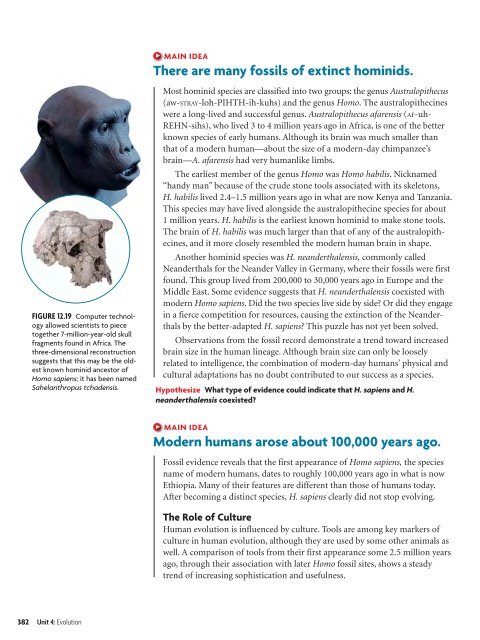12 The History of Life
12 The History of Life
12 The History of Life
- No tags were found...
Create successful ePaper yourself
Turn your PDF publications into a flip-book with our unique Google optimized e-Paper software.
MAIN IDEA<strong>The</strong>re are many fossils <strong>of</strong> extinct hominids.FIGURE <strong>12</strong>.19 Computer technologyallowed scientists to piecetogether 7-million-year-old skullfragments found in Africa. <strong>The</strong>three-dimensional reconstructionsuggests that this may be the oldestknown hominid ancestor <strong>of</strong>Homo sapiens; it has been namedSahelanthropus tchadensis.Most hominid species are classified into two groups: the genus Australopithecus(aw-STRAY-loh-PIHTH-ih-kuhs) and the genus Homo. <strong>The</strong> australopithecineswere a long-lived and successful genus. Australopithecus afarensis (AF-uh-REHN-sihs), who lived 3 to 4 million years ago in Africa, is one <strong>of</strong> the betterknown species <strong>of</strong> early humans. Although its brain was much smaller thanthat <strong>of</strong> a modern human—about the size <strong>of</strong> a modern-day chimpanzee’sbrain—A. afarensis had very humanlike limbs.<strong>The</strong> earliest member <strong>of</strong> the genus Homo was Homo habilis. Nicknamed“handy man” because <strong>of</strong> the crude stone tools associated with its skeletons,H. habilis lived 2.4–1.5 million years ago in what are now Kenya and Tanzania.This species may have lived alongside the australopithecine species for about1 million years. H. habilis is the earliest known hominid to make stone tools.<strong>The</strong> brain <strong>of</strong> H. habilis was much larger than that <strong>of</strong> any <strong>of</strong> the australopithecines,and it more closely resembled the modern human brain in shape.Another hominid species was H. neanderthalensis, commonly calledNeanderthals for the Neander Valley in Germany, where their fossils were firstfound. This group lived from 200,000 to 30,000 years ago in Europe and theMiddle East. Some evidence suggests that H. neanderthalensis coexisted withmodern Homo sapiens. Did the two species live side by side? Or did they engagein a fierce competition for resources, causing the extinction <strong>of</strong> the Neanderthalsby the better-adapted H. sapiens? This puzzle has not yet been solved.Observations from the fossil record demonstrate a trend toward increasedbrain size in the human lineage. Although brain size can only be looselyrelated to intelligence, the combination <strong>of</strong> modern-day humans’ physical andcultural adaptations has no doubt contributed to our success as a species.Hypothesize What type <strong>of</strong> evidence could indicate that H. sapiens and H.neanderthalensis coexisted?MAIN IDEAModern humans arose about 100,000 years ago.Fossil evidence reveals that the first appearance <strong>of</strong> Homo sapiens, the speciesname <strong>of</strong> modern humans, dates to roughly 100,000 years ago in what is nowEthiopia. Many <strong>of</strong> their features are different than those <strong>of</strong> humans today.After becoming a distinct species, H. sapiens clearly did not stop evolving.<strong>The</strong> Role <strong>of</strong> CultureHuman evolution is influenced by culture. Tools are among key markers <strong>of</strong>culture in human evolution, although they are used by some other animals aswell. A comparison <strong>of</strong> tools from their first appearance some 2.5 million yearsago, through their association with later Homo fossil sites, shows a steadytrend <strong>of</strong> increasing sophistication and usefulness.382 Unit 4: Evolution

















